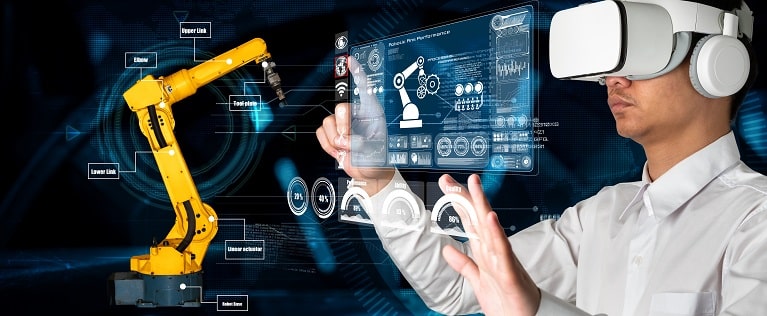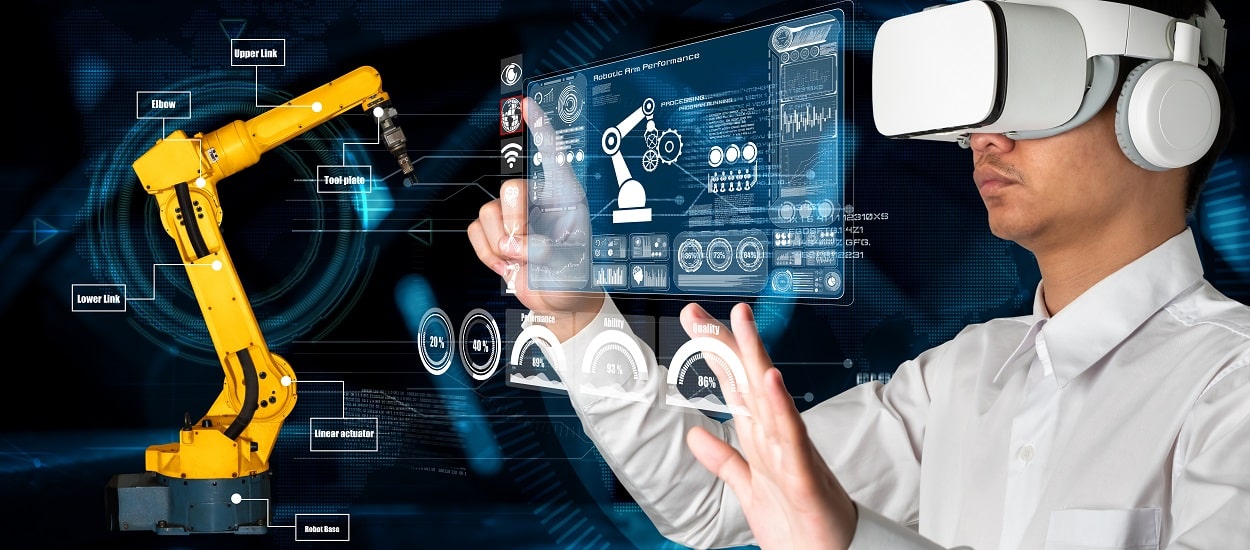Virtual Reality (VR) breaks the limitations of the physical world and lets the user immerse entirely in a computer-generated environment, where they can explore the product with a 360-degree view and manipulate virtual objects.
A few years ago, VR technology was mainly used in only the gaming or entertainment sector. But today, it is used extensively in the industrial sector for training, research, product demonstration, simulations, and more. Increasingly, businesses are prioritizing opportunities that can empower their entire workforce with easy accessibility and information exchange across time, place, and mobility barriers. In addition, VR plays an important role in the developing Metaverse alongside technologies such as 5G, the Internet of Things (IoT), Augmented Reality, Artificial Intelligence, and Blockchain.Immersive technologies like Virtual Reality and Mixed Reality aren’t just changing how we create and consume content. These technologies play an important role in achieving Industry 4.0 goals. They also help businesses become more resilient by reimagining workforce productivity, training, and customer service solutions.
Virtual Reality use cases
VR provides immediate benefits across multiple use cases. Let’s look at the three of the most promising use cases of VR in the industrial sector – immersive training, innovative product demonstration, and product design.
Training: Immersive training experience in a risk-free environment
Organizations spend significant time and resources training their industrial workers with skills to increase efficiency. Classroom-based or online training programs are often time-consuming and require extensive involvement of trainers and employees.
Immersive learning, enabled by Virtual Reality, allows trainees to perform complex and sometimes dangerous tasks in a risk-free virtual environment, much before the employees perform them in the real world. The VR-based training methodology helps them prepare for challenging situations by practicing them in a safe environment where they can build their skills and confidence. As VR-based training experience combines visuals, interactions, and immersion, it's a more effective training method and has a higher knowledge retention rate.
VR-enabled training helps in the following ways:
- Cost-effective training: – Upskilling or re-skilling employees is a recurring process that requires constant availability of trainers, tools, and machines. Upskilling using Virtual Reality technology is long-term, cost-effective, and engaging. The trainees can interact with virtual tools, trainers, and machines to acquire new skills.
- Training assessment using performance analytics: – A common challenge for any industry is about onboarding new talent and training them, whether on the shop floor, with tools, about assembly & disassembly of complex machines, or in selling products to target customers, field service, repair & maintenance activities and so on. Leveraging interactive training doesn’t just reduce the overall cost and time but also enables the trainee to gauge the performance of their training through performance analytics.
- Simulate complex mechanisms – Training employees can be difficult, risky, and expensive. Especially when the machines, products, field service, maintenance & repair activities are complex and sophisticated. This complexity acts as a barrier and leads to fewer employees becoming capable of performing a task. In such a situation, Virtual Reality technology helps achieve cost-effective, risk-free training in a virtual environment.
- A global training solution – To meet the training needs of employees, an organization often replicates physical infrastructure for training across multiple locations. This physical infrastructure is augmented by onboarding a training team or experts at each location. All this adds training costs, yet the training curriculum is critically dependent on the availability of trainers and infrastructure. Leveraging an interactive training program that mimics the actual scenario with multilingual support overcomes all these challenges.
Sales & Marketing: Immersive product demonstration for enhanced customer experience
The new normal has created conditions for companies to think of alternative means to showcase and demonstrate their products to prospective customers. Digital customer experience centers have enabled brands to showcase their products engagingly and interactively.
Utilizing Virtual Reality technology allows customers to experience the product, which aids them in decision-making.
VR-enabled product demonstration use cases have been able to:
- Provide an immersive experience to customers – Using Virtual Reality headsets for product demonstrations provides prospects with a unique, immersive experience. This approach allows the prospects to experience the product, like its technical features, quality, product parts, operation, and safety. It is one of the best ways to inform customers and help them make purchase decisions.
- Provide detailed visual information – A digital product experience center offers an opportunity to showcase products of all kinds, irrespective of their size, weight, and volume. In such a digital product experience center, we can display more information related to the product visually and in text format based on customer interest. This enables a one-to-one interaction with the product without any disturbance.
- Be accessible anytime – Virtual Reality technology is evolving exponentially, providing immersive experiences for practically any product, anytime and anywhere. This enables businesses to approach prospective customers with an innovative and comfortable experience while saving time and resources.
- Stepping stone to Metaverse – A concept such as a digital customer experience center is a functional shift for industrial companies. It drives them to create an interactive virtual space for product demonstrations in the Metaverse. At Nagarro, we think the Metaverse will significantly influence the Industry and Automation space.
- It will help create a collective virtual shared space created by the convergence of different technologies, such as IoT, blockchain, AI, and enhanced physical and digital reality. Its applications will range from product demonstrations to virtual events and from simulations to digital twins.
Product Design: Accelerate product development
Virtual Reality is making a significant impact on product design for industrial organizations. The limited flexibility of collaboration and customization in the two-dimensional and three-dimensional design approach does not express the designers’ intent/ideas aptly. The use of Virtual Reality in industrial design solves this challenge by enabling relevant stakeholders to interact with the virtual digital model at different stages of product development. It allows them to experiment, interact with the digital model, and customize it as per the business objective. This approach enables the stakeholders to visualize the design before building the product.
As evident by results across various customers and industries, these VR-enabled product design use cases have provided the following benefits:
- Enhanced design process: – Virtual Reality makes the design process more immersive. It allows designers to scrutinize prototypes closely before building the actual product. This approach reduces errors and improves product quality.
- Easy collaboration with relevant stakeholders: – VR allows remote and real-time collaboration with relevant stakeholders to understand their point of view on the product design, add relevant details of the product, and solve the problem together.
- Quicker return on investment (ROI): – The use of VR modeling software in the design process is more beneficial than traditional design. It fast-tracks the design lifecycle and results in quicker approvals of designs. A lower margin of error in the design process can ensure fewer prototypes, creating significant cost reduction and higher savings.
How can Nagarro help?
Nagarro has a team of experts comprising VR technology experts, business consultants, and 3D designers who excel at digital product engineering. Our team members are powered by a ‘Caring’ culture that focuses on delivering the best results and VR solutions for our clients across a wide array of use cases. They collaborate closely with our clients to develop Virtual Reality solutions, conduct field trials, and then scale and industrialize solutions.
We have also developed a suite of software accelerators with key functionalities that form the basis of the most common Virtual Reality use cases. These accelerators have been field-tested and can be integrated as per the use case, leading to faster solution delivery.
Inspired by our ‘Thinking Breakthroughs’ approach, we have created frameworks and toolkits to assist in use case identification and their agile development. Depending on where you are in your digitalization journey, Nagarro can help create a proof of value, a minimum viable product, or a complete solution. Our partner ecosystem further creates a multiplier effect to support you along that journey.
Are you looking to start or accelerate your digital journey with Virtual Reality? We are happy to help! Explore our offerings and get connected with our experts.




-2.png)

